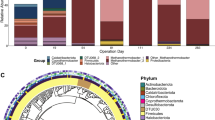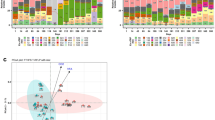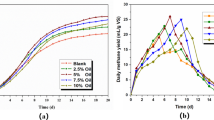Abstract
Inhibition of anaerobic digestion through accumulation of volatile fatty acids occasionally occurs as the result of unbalanced growth between acidogenic bacteria and methanogens. A fast recovery is a prerequisite for establishing an economical production of biogas. However, very little is known about the microorganisms facilitating this recovery. In this study, we investigated the organisms involved by a novel approach of mapping protein-stable isotope probing (protein-SIP) onto a binned metagenome. Under simulation of acetate accumulation conditions, formations of 13C-labeled CO2 and CH4 were detected immediately following incubation with [U-13C]acetate, indicating high turnover rate of acetate. The identified 13C-labeled peptides were mapped onto a binned metagenome for improved identification of the organisms involved. The results revealed that Methanosarcina and Methanoculleus were actively involved in acetate turnover, as were five subspecies of Clostridia. The acetate-consuming organisms affiliating with Clostridia all contained the FTFHS gene for formyltetrahydrofolate synthetase, a key enzyme for reductive acetogenesis, indicating that these organisms are possible syntrophic acetate-oxidizing (SAO) bacteria that can facilitate acetate consumption via SAO, coupled with hydrogenotrophic methanogenesis (SAO-HM). This study represents the first study applying protein-SIP for analysis of complex biogas samples, a promising method for identifying key microorganisms utilizing specific pathways.
Similar content being viewed by others
Log in or create a free account to read this content
Gain free access to this article, as well as selected content from this journal and more on nature.com
or
Accession codes
References
Albertsen M, Hugenholtz P, Skarshewski A, Nielsen KL, Tyson GW, Nielsen PH . (2013). Genome sequences of rare, uncultured bacteria obtained by differential coverage binning of multiple metagenomes. Nat Biotechnol 31: 533–538.
Angelidaki I, Ahring BK . (1993). Thermophilic anaerobic digestion of livestock waste: the effect of ammonia. Appl Microbiol Biotechnol 38: 560–564.
Balk M, Weijma J, Stams AJM . (2002). Thermotoga lettingae sp. nov., a novel thermophilic, methanol-degrading bacterium isolated from a thermophilic anaerobic reactor. Int J Syst Evol Microbiol 52: 1361–1368.
Bastida F, Rosell M, Franchini AG, Seifert J, Finsterbusch S, Jehmlich N et al. (2010). Elucidating MTBE degradation in a mixed consortium using a multidisciplinary approach. FEMS Microbiol Ecol 73: 370–384.
Blume F, Bergmann I, Nettmann E, Schelle H, Rehde G, Mundt K et al. (2010). Methanogenic population dynamics during semi-continuous biogas fermentation and acidification by overloading. J Appl Microbiol 109: 441–450.
Botelho D, Wall MJ, Vieira DB, Fitzsimmons S, Liu F, Doucette A . (2010). Top-down and bottom-up proteomics of SDS-containing solutions following mass-based separation. J Proteome Res 9: 2863–2870.
Can M, Armstrong FA, Ragsdale SW . (2014). Structure, function, and mechanism of the nickel metalloenzymes, CO dehydrogenase, and acetyl-CoA synthase. Chem Rev 114: 4149–4174.
Chen Y, Cheng JJ, Creamer KS . (2008). Inhibition of anaerobic digestion process: a review. Bioresource Technol 99: 4044–4064.
De Vrieze J, Hennebel T, Boon N, Verstraete W . (2012). Methanosarcina: the rediscovered methanogen for heavy duty biomethanation. Bioresource Technol 112: 1–9.
Demirel B, Yenigün O . (2002). Two-phase anaerobic digestion processes: a review. J Chem Technol Biotechnol 77: 743–755.
Doherty MK, Beynon RJ . (2006). Protein turnover on the scale of the proteome. Exp Rev Proteomics 3: 97–110.
Ermler U . (1997). Crystal structure of methyl-coenzyme M reductase: the key enzyme of biological methane formation. Science 278: 1457–1462.
Finn RD, Bateman A, Clements J, Coggill P, Eberhardt RY, Eddy SR et al. (2014). Pfam: the protein families database. Nucl Acids Res 42: D222–D230.
Fotidis IA, Karakashev D, Angelidaki I . (2013). Bioaugmentation with an acetate-oxidising consortium as a tool to tackle ammonia inhibition of anaerobic digestion. Bioresource Technol 146: 57–62.
Grabarse W, Mahlert F, Duin EC, Goubeaud M, Shima S, Thauer RK et al. (2001). On the mechanism of biological methane formation: structural evidence for conformational changes in methyl-coenzyme M reductase upon substrate binding. J Mol Biol 309: 315–330.
Hagen LH, Vivekanand V, Linjordet R, Pope PB, Eijsink VGH, Horn SJ . (2014). Microbial community structure and dynamics during co-digestion of whey permeate and cow manure in continuous stirred tank reactor systems. Bioresource Technol 171: 350–359.
Hansen SH, Stensballe A, Nielsen PH, Herbst F-A . (2014). Metaproteomics: evaluation of protein extraction from activated sludge. Proteomics 14: 2535–2539.
Hao L, Lü F, Mazéas L, Desmond-Le Quéméner E, Madigou C, Guenne A et al. (2014). Stable isotope probing of acetate fed anaerobic batch incubations shows a partial resistance of acetoclastic methanogenesis catalyzed by Methanosarcina to sudden increase of ammonia level. Water Res 69C: 90–99.
Hattori S, Kamagata Y, Hanada S, Shoun H . (2000). Thermacetogenium phaeum gen. nov., sp. nov., a strictly anaerobic, thermophilic, syntrophic acetate-oxidizing bacterium. Int J Syst Evol Microbiol 50 (Pt 4): 1601–1609.
Hattori S . (2008). Syntrophic acetate-oxidizing microbes in methanogenic environments. Microbes Environ 23: 118–127.
Herbst F-A, Bahr A, Duarte M, Pieper DH, Richnow H-H, von Bergen M et al. (2013). Elucidation of in situ polycyclic aromatic hydrocarbon degradation by functional metaproteomics (protein-SIP). Proteomics 13: 2910–2920.
Heyer R, Kohrs F, Benndorf D, Rapp E, Kausmann R, Heiermann M et al. (2013). Metaproteome analysis of the microbial communities in agricultural biogas plants. New Biotechnol 30: 614–622.
Hori T, Sasaki D, Haruta S, Shigematsu T, Ueno Y, Ishii M et al. (2011). Detection of active, potentially acetate-oxidizing syntrophs in an anaerobic digester by flux measurement and formyltetrahydrofolate synthetase (FTHFS) expression profiling. Microbiology (Reading, England) 157: 1980–1989.
Ito T, Yoshiguchi K, Ariesyady HD, Okabe S . (2011). Identification of a novel acetate-utilizing bacterium belonging to Synergistes group 4 in anaerobic digester sludge. ISME J 5: 1844–1856.
Jehmlich N, Schmidt F, Taubert M, Seifert J, Bastida F, von Bergen M et al. (2010). Protein-based stable isotope probing. Nat Protocols 5: 1957–1966.
Jehmlich N, Schmidt F, von Bergen M, Richnow H-H, Vogt C . (2008). Protein-based stable isotope probing (Protein-SIP) reveals active species within anoxic mixed cultures. ISME J 2: 1122–1133.
Karakashev D, Batstone DJ, Trably E, Angelidaki I . (2006). Acetate oxidation is the dominant methanogenic pathway from acetate in the absence of Methanosaetaceae. Appl Environ Microbiol 72: 5138–5141.
Kim J, Shin SG, Han G, O’Flaherty V, Lee C, Hwang S . (2011). Common key acidogen populations in anaerobic reactors treating different wastewaters: molecular identification and quantitative monitoring. Water Res 45: 2539–2549.
Kjeldal H, Pell L, Pommerening-Röser A, Nielsen JL . (2014). Influence of p-cresol on the proteome of the autotrophic nitrifying bacterium Nitrosomonas eutropha C91. Arch Microbiol 196: 497–511.
Kleindienst S, Herbst F-A, Stagars M, von Netzer F, von Bergen M, Seifert J et al. (2014). Diverse sulfate-reducing bacteria of the Desulfosarcina/Desulfococcus clade are the key alkane degraders at marine seeps. ISME J 8: 2029–2044.
Klocke M, Mähnert P, Mundt K, Souidi K, Linke B . (2007). Microbial community analysis of a biogas-producing completely stirred tank reactor fed continuously with fodder beet silage as mono-substrate. Syst Appl Microbiol 30: 139–151.
Kohlbacher O, Reinert K, Gröpl C, Lange E, Pfeifer N, Schulz-Trieglaff O et al. (2007). TOPP—the OpenMS proteomics pipeline. Bioinforma Oxf Engl 23: e191–e197.
Krakat N, Schmidt S, Scherer P . (2011). Potential impact of process parameters upon the bacterial diversity in the mesophilic anaerobic digestion of beet silage. Bioresource Technol 102: 5692–5701.
Labatut RA, Angenent LT, Scott NR . (2014). Conventional mesophilic vs. thermophilic anaerobic digestion: a trade-off between performance and stability? Water Res 53: 249–258.
Lee S-H, Kang H-J, Lee YH, Lee TJ, Han K, Choi Y et al. (2012). Monitoring bacterial community structure and variability in time scale in full-scale anaerobic digesters. J Environ Monitor 14: 1893–1905.
Lee ZM-P, Bussema C, Schmidt TM . (2009). rrnDB: documenting the number of rRNA and tRNA genes in bacteria and archaea. Nucleic Acids Res 37: D489–D493.
Liu Y, Boone DR, Sleat R, Mah RA . (1985). Methanosarcina mazei LYC, a new methanogenic isolate which produces a disaggregating enzyme. Appl Environ Microbiol 49: 608–613.
Lovell CR, Leaphart AB . (2005). Community-level analysis: key genes of CO2-reductive acetogenesis. Methods Enzymol 397: 454–469.
Lü F, Hao L, Guan D, Qi Y, Shao L, He P . (2013). Synergetic stress of acids and ammonium on the shift in the methanogenic pathways during thermophilic anaerobic digestion of organics. Water Res 47: 2297–2306.
Manzoor S, Müller B, Niazi A, Bongcam-Rudloff E, Schnürer A . (2013). Draft genome sequence of Clostridium ultunense strain esp, a syntrophic acetate-oxidizing bacterium. Genome Announcements 1: e0010713.
Mikucki JA, Liu Y, Delwiche M, Colwell FS, Boone DR . (2003). Isolation of a methanogen from deep marine sediments that contain methane hydrates, and description of Methanoculleus submarinus sp. nov. Appl Environ Microbiol 69: 3311–3316.
Mulat DG, Ward AJ, Adamsen APS, Voigt NV, Nielsen J, Feilberg A . (2014). Quantifying contribution of synthrophic acetate oxidation to methane production in thermophilic anaerobic reactors by membrane inlet mass spectrometry. Environ Sci Technol 48: 2505–2511.
Müller B, Sun L, Schnürer A . (2013). First insights into the syntrophic acetate-oxidizing bacteria—a genetic study. Microbiol Open 2: 35–53.
Palatsi J, Viñas M, Guivernau M, Fernandez B, Flotats X . (2011). Anaerobic digestion of slaughterhouse waste: main process limitations and microbial community interactions. Bioresource Technol 102: 2219–2227.
Patil SS, Kumar MS, Ball AS . (2010). Microbial community dynamics in anaerobic bioreactors and algal tanks treating piggery wastewater. Appl Microbiol Biotechnol 87: 353–363.
Petersen S . (1991). Acetate oxidation in a thermophilic anaerobic sewage-sludge digestor: the importance of non-aceticlastic methanogenesis from acetate. FEMS Microbiol Lett 86: 149–152.
Rademacher A, Zakrzewski M, Schlüter A, Schönberg M, Szczepanowski R, Goesmann A et al. (2012). Characterization of microbial biofilms in a thermophilic biogas system by high-throughput metagenome sequencing. FEMS Microbiol Ecol 79: 785–799.
Rajagopal R, Massé DI, Singh G . (2013). A critical review on inhibition of anaerobic digestion process by excess ammonia. Bioresource Technol 143: 632–641.
Rodríguez E, Lopes A, Fdz-Polanco M, Stams AJM, García-Encina PA . (2012). Molecular analysis of the biomass of a fluidized bed reactor treating synthetic vinasse at anaerobic and micro-aerobic conditions. Appl Microbiol Biotechnol 93: 2181–2191.
Sachsenberg T, Herbst F-A, Taubert M, Kermer R, Jehmlich N, von Bergen M et al. (2015). MetaProSIP: automated inference of stable isotope incorporation rates in proteins for functional metaproteomics. J Proteome Res 14: 619–627.
Sasaki D, Hori T, Haruta S, Ueno Y, Ishii M, Igarashi Y . (2011). Methanogenic pathway and community structure in a thermophilic anaerobic digestion process of organic solid waste. J Biosci Bioeng 111: 41–46.
Schlüter A, Bekel T, Diaz NN, Dondrup M, Eichenlaub R, Gartemann K-H et al. (2008). The metagenome of a biogas-producing microbial community of a production-scale biogas plant fermenter analysed by the 454-pyrosequencing technology. J Biotechnol 136: 77–90.
Schnürer A, Schink B, Svensson BH . (1996). Clostridium ultunense sp. nov., a mesophilic bacterium oxidizing acetate in syntrophic association with a hydrogenotrophic methanogenic bacterium. Int J Syst Bacteriol 46: 1145–1152.
Seifert J, Herbst F-A, Halkjaer Nielsen P, Planes FJ, Jehmlich N, Ferrer M et al. (2013). Bioinformatic progress and applications in metaproteogenomics for bridging the gap between genomic sequences and metabolic functions in microbial communities. Proteomics 13: 2786–2804.
Shevchenko A, Tomas H, Havlis J, Olsen J V, Mann M . (2006). In-gel digestion for mass spectrometric characterization of proteins and proteomes. Nat Protocols 1: 2856–2860.
St-Pierre B, Wright A-DG . (2014). Comparative metagenomic analysis of bacterial populations in three full-scale mesophilic anaerobic manure digesters. Appl Microbiol Biotechnol 98: 2709–2717.
Sturm M, Bertsch A, Gröpl C, Hildebrandt A, Hussong R, Lange E et al. (2008). OpenMS - an open-source software framework for mass spectrometry. BMC Bioinformatics 9: 163.
Sundberg C, Al-Soud WA, Larsson M, Alm E, Yekta SS, Svensson BH et al. (2013). 454 pyrosequencing analyses of bacterial and archaeal richness in 21 full-scale biogas digesters. FEMS Microbiol Ecol 85: 612–626.
Taubert M, Jehmlich N, Vogt C, Richnow HH, Schmidt F, von Bergen M et al. (2011). Time resolved protein-based stable isotope probing (protein-SIP) analysis allows quantification of induced proteins in substrate shift experiments. Proteomics 11: 2265–2274.
Taubert M, Vogt C, Wubet T, Kleinsteuber S, Tarkka MT, Harms H et al. (2012). Protein-SIP enables time-resolved analysis of the carbon flux in a sulfate-reducing, benzene-degrading microbial consortium. ISME J 6: 2291–2301.
Thauer RK, Kaster A-K, Seedorf H, Buckel W, Hedderich R . (2008). Methanogenic archaea: ecologically relevant differences in energy conservation. Nat Rev Microbiol 6: 579–591.
Tuan NN, Chang Y-C, Yu C-P, Huang S-L . (2014). Multiple approaches to characterize the microbial community in a thermophilic anaerobic digester running on swine manure: a case study. Microbiol Res 169: 717–724.
Vizcaíno JA, Deutsch EW, Wang R, Csordas A, Reisinger F, Ríos D et al. (2014). ProteomeXchange provides globally coordinated proteomics data submission and dissemination. Nat Biotechnol 32: 223–226.
Westerholm M, Roos S, Schnürer A . (2010). Syntrophaceticus schinkii gen. nov., sp. nov., an anaerobic, syntrophic acetate-oxidizing bacterium isolated from a mesophilic anaerobic filter. FEMS Microbiol Lett 309: 100–104.
Westerholm M, Roos S, Schnürer A . (2011). Tepidanaerobacter acetatoxydans sp. nov., an anaerobic, syntrophic acetate-oxidizing bacterium isolated from two ammonium-enriched mesophilic methanogenic processes. Syst Appl Microbiol 34: 260–266.
Wirth R, Kovács E, Maróti G, Bagi Z, Rákhely G, Kovács KL . (2012). Characterization of a biogas-producing microbial community by short-read next generation DNA sequencing. Biotechnol Biofuels 5: 41.
Xu K, Liu H, Du G, Chen J . (2009). Real-time PCR assays targeting formyltetrahydrofolate synthetase gene to enumerate acetogens in natural and engineered environments. Anaerobe 15: 204–213.
Ziganshina EE, Bagmanova AR, Khilyas I V, Ziganshin AM . (2014). Assessment of a biogas-generating microbial community in a pilot-scale anaerobic reactor. J Biosci Bioeng 117: 730–736.
Acknowledgements
This study was part of the project HYdrogen CONtrol for Optimization of Methane Production from Livestock Waste (HYCON) funded by the Danish Strategic Research Council (grant no. 10-093944).
Author information
Authors and Affiliations
Corresponding author
Ethics declarations
Competing interests
The authors declare no conflict of interest.
Additional information
Supplementary Information accompanies this paper on The ISME Journal website
Rights and permissions
About this article
Cite this article
Mosbæk, F., Kjeldal, H., Mulat, D. et al. Identification of syntrophic acetate-oxidizing bacteria in anaerobic digesters by combined protein-based stable isotope probing and metagenomics. ISME J 10, 2405–2418 (2016). https://doi.org/10.1038/ismej.2016.39
Received:
Revised:
Accepted:
Published:
Issue date:
DOI: https://doi.org/10.1038/ismej.2016.39
This article is cited by
-
Energetically exploiting lignocellulose-rich residues in anaerobic digestion technologies: from bioreactors to proteogenomics
Biotechnology for Biofuels and Bioproducts (2023)
-
Metabolic Functional Profiles of Microbial Communities in Methane Production Systems Treating Winery Wastewater
BioEnergy Research (2023)
-
Biomethane production and microbial strategies corresponding to high organic loading treatment for molasses wastewater in an upflow anaerobic filter reactor
Bioprocess and Biosystems Engineering (2023)
-
Functional and molecular approaches for studying and controlling microbial communities in anaerobic digestion of organic waste: a review
Reviews in Environmental Science and Bio/Technology (2023)
-
Adaptation of a microbial community to demand-oriented biological methanation
Biotechnology for Biofuels and Bioproducts (2022)



